Top News
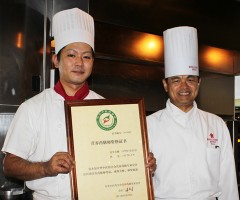
July 21, 2013 Ryukyu Shimpo
Chef at the Hotel Yugafuin in Nago, Go Shimabukuro, is the first person in Okinawa to pass the examination to become a Yakuzen Dietetics Master. Yakuzen is medically beneficial food based on the Chinese tradition that a balanced diet creates a healthy body.
Shimabukuro said, “I am still very much at the learning stage, but I would like to create Yakuzen cuisine using the ingredients from the Yambaru.”
His interest in Yakuzen saw Shimabukuro enter the first intake of students in the correspondence course for Yakuzen cooking dietetics, which he completed last September. The Japan Association of Chinese Cuisine and Dietetics Yakuzen Chapter of the Chinese Pharmaceutical Association deliver the course. When Shimabukuro passed examinations about theory, recipe creation and technique he became a Yakuzen Dietetics Master.
Shimabukuro offers healthy dishes in the Hotel Yugafuin. On the Yakuzen menu, he serves nutrient-rich soup using winter melon that contains ingredients to help make the skin beautiful and to cure swelling from oedema. He also serves Okinawan pork roast using the sauce made from Peucedanum japonicum that may have anticancer benefits.
The managing director of the hotel, Akito Kawakami, who also has worked in Chinese cuisine, said, “Combining ingredients is important in Yakuzen. It is great that Shimabukuro is creating Yakuzen dishes for our customers.”
The hotel plans to hold a Yakuzen cuisine fair in August. Shimabukuro said, “I want to serve seasonal Yakuzen dishes and for customers to enjoy trying them.”
(English translation by T&CT, Mark Ealey)
Go to Japanese
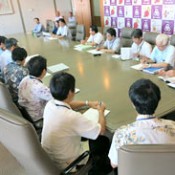
July 25, 2013 Ryukyu Shimpo
Construction workers unearthed dozens of barrels marked with the logo of the Dow Chemical Company at a soccer ground on land returned by the U.S. military in Okinawa City. The Okinawa Defense Bureau said on July 24 that it detected dioxin and other harmful ingredients in the fouling material inside the barrels and in water near the location. The levels found exceeded the Environmental Quality Standard set by the Japanese government. During the Vietnam War, the United States based chemical manufacturer produced Agent Orange, a chemical defoliant containing dioxin.
The bureau detected dioxin in fouling material at a level 1.1 times the normal standard for soil, and in the water it was 28 times the standard for groundwater. Experts insist that this is a variety of dioxin related to the defoliant.
The bureau reported the results of their investigation in a meeting held in the city government office on the morning of July 24. The meeting involved representatives of the bureau, the Okinawa Prefectural Government and Okinawa City Government. Afterwards, Okinawa City Mayor Mitsuko Tomon announced that a full-scale investigation will be carried out at the soccer ground. The three parties plan to deal with the issue after the city government releases the investigation results at the end of this month.
The bureau detected dioxin in all the 22 analytes from the barrels. Two exceeded the standard and the highest value was 1,100 picograms TEQ per gram. The others ranged from 62 to 1,000 picograms. TEQ stands for Toxicity Equivalence Quantity, which indicates the toxicity of dioxins.
The dioxin in the water around the soil was 28 picograms TEQ per liter.
The bureau found the key ingredient of Agent Orange – 2, 4, 5-T, trichlorophenoxyacetic acid, in 13 of the analytes from the barrels. They did not detect the other key ingredient of the defoliant – 2, 4-dichlorophenoxyacetic. The bureau said they cannot say for sure that Agent Orange was in the containers.
They explained that the U.S. military used 2, 4, 5-trichlorophenoxyacetic acid in many herbicides during the Vietnam War. A bureau representative said, “It is possible the barrels contained Agent Orange.”
At the site, the bureau found a large quantity of 2, 3, 7, 8-tetrachlorodibenzo, an ingredient unique to the defoliant. Katsuhisa Honda, a professor at Ehime University, who studies dioxin and techniques for its analysis, focuses on this fact.
Honda asserted, “I am sure the barrels contained dioxin related to Agent Orange because the ingredient accounted for 70 percent of the chemical.” He emphasized the need to clean the contaminated soil.
The bureau did not detect polychlorinated biphenyls in the barrels or around the soil. They found 140 picograms of dioxin TEQ per gram, which is lower than the standard, in the soil. Levels of arsenicum and fluorine found were slightly lower than the standard.
(English translation by T&CT, Mark Ealey)
Go to Japanese
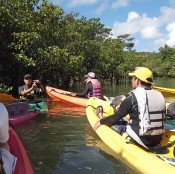
July 14, 2013 Ryukyu Shimpo
Residents considered the potential of local tourism, including experience-based tourism focusing on the Haneji Inland Sea in Nago. On July 10, they listened to a lecture and took part in a sea-kayak tour. The Nago City Tourism Association organized the project. Many people from the Goga, Gabusoka, Nakaoshi, Uchiara and Kogachi and Burikena districts took part in the meeting. They discussed how to make the community more appealing by taking advantage of the natural environment of the sea, rivers, forest and culture in the Haneji area.
After leaving Nasadagawa, they went to the Haneji Inland Sea by sea kayak along the Gabusoka River. About 20 people enjoyed looking for crabs among the mangroves and seeing beach hibiscus by the riverside. Satoru Nakamura, a staff member of the City Tourism Association served as a guide and Hiroko Sakashita of the Yagaji Ekotsu (Eco-tour) Net helped with this study tour. Those involved enjoyed going along the river by sea kayak. Hayashi Kishimoto, chairperson of the Nago City Research Committee for the Preservation of Cultural Assets, gave a lecture at the Gabe Community Center. He suggested making use of local agricultural products such as tea and pineapples, highlighting the history of the community and the presence of an attractive waterfall.
One person commented, “If you will plant parsonsia laevigata that rice paper butterflies eat, tourists also can enjoy seeing those butterflies as they go down the river.” Another said, “There is a road alongside the river. We can promote this area as a safe place for visitors.”
Kenshin Kadekaru, head of Goga Ward said, “We now understand that our community has great potential for tourism. We are trying to develop the local community by making use of the Haneji Inland Sea.”
(English translation by T&CT, Mark Ealey)
Go to Japanese

July 14, 2013 Ryukyu Shimpo
A firework display was held in Motobu in the evening of July 13 as part of the Ocean Expo Park Summer Festival 2013. According to the organizer, 42,403 people attended the festival and enjoyed the sky lit up with 10,000 fireworks.
The festival unveiled “Suiku,” a low-bursting firework. Enthralled by the various fireworks, the crowd cheered when they saw the flashes reflected on the sea’s surface. They also enjoyed the “Niagara” fireworks in which the sparks flew 300 meters across the sky.
(English translation by T&CT, Hitomi Shinzato and Mark Ealey)
Go to Japanese

July 14, 2013 Ryukyu Shimpo
Ninety-seven-year-old Shinfuku Tamaki lives in Ogimi, which is known for the longevity of its residents.
Tamaki enjoys riding a 125cc motorcycle that his children and grandchildren gave him for his birthday this May.
He uses it to go from his house to the fields, the shops and the local branch of the Japan Agricultural Cooperatives. He enjoys riding the bike, saying, “This new one is really comfortable.”
Tamaki doesn’t have a driver’s license for a car, so has been riding motorcycles for more than 50 years.
When he was young, Tamaki liked motorbikes so much that he even commuted to Naha on one. He has ridden four bikes in total.
His children and grandchildren gave him a new motorcycle for his birthday on May 28 because they were concerned that his previous bike, which he had used for 15 years, was no longer usable.
In 6,612 square meters of fields in seven different places, Tamaki works by himself to grow citrus depressa and tankan mandarin. On his motorbike, he goes up the steep hill to the citrus depressa field two or three minutes away from his house.
Tamaki looked busy, saying, “I don’t time to go far as the harvest starts soon.”
On his new bike, Tamaki looks young, much younger than 97.
(English translation by T&CT, Mark Ealey)
Go to Japanese

July 15, 2013 Ryukyu Shimpo
Pink Dot Okinawa, an event for sexual minorities, was held in the open space in front of the Tenbus Building in Makishi, Naha on July 14. The event aims to help make society comfortable for sexual minorities. A total of 800 people took part.
Pick Dot events started in Singapore in 2009 and have spread to various parts of the world. This is the first time the event has been held in Japan. Anyone, is welcome to take part, including people in sexual minorities or heterosexuals. Understanding the importance of acknowledging and supporting one another, the participants dressed in pink.
(English translation by T&CT, Mark Ealey)
Go to Japanese
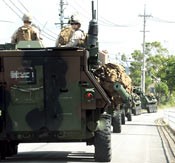
July 16, 2013 Ryukyu Shimpo
A convoy of ten U.S. military amphibious vehicles drove through Village Road No. 1 in Shirohara, Ginoza on July 15. Because the road through the village is only narrow the residents oppose such vehicles using it because of the risk of accidents. The U.S. military actually forbids its vehicles from using the road, but nevertheless occasionally heavy military vehicles cut through the road.
Heading towards Camp Hansen, the vehicles entered the road through Shirohara just after 10:00a.m. They often went a significant distance across into the lane for oncoming traffic and their radio aerials sometimes touched the branches of trees.
The Okinawa Prefectural Government provides the U.S. military with access to the road. In 1995, a heavy military truck hit and killed a child. In response to locals’ requests, in 1997 the commander of Camp Hansen promised that they would not use the road except in emergencies, but as in this case, U.S. military vehicles still occasionally use the road.
(English translation by T&CT, Lima Tokumori and Mark Ealey)
Go to Japanese
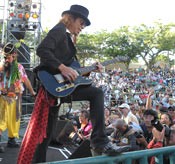
July 15, 2013 Ryukyu Shimpo
About 1,600 rock fans crowded into the Okinawa City Open Air Stage on July 14, in the final day of the 31st Peaceful Love Rock Festival 2013. Ten bands from Okinawa and other prefectures took part and this year Rock N’ Roll Band Murasaki was the last performer. The crowd was whipped into a frenzy when the group performed one of its heavy, original pieces.
Veteran rock groups, including Pryzm, Jet and Kachan & Rainbow, which perform in Okinawa City (formerly Koza City), took part in the festival. People enjoyed the big rock festival, now an annual summer event, raising their hands and moving their bodies in front of the stage. The festival held in Okinawa City on July 13 and 14 was sponsored by the Executive Committee, Okinawa City and the Okinawa City Tourism Association.
(English translation by T&CT, Mark Ealey)
Go to Japanese

Go To Video
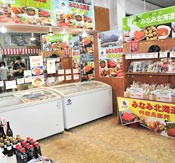
July 17, 2013 Ryukyu Shimpo
Miyagi Store at the Ichiban Gai shopping avenue in the center of Okinawa City opened a permanent retail booth on July 5 for “Tastes of the North.” The store aims to promote products from Hokkaido. The store is doing this in cooperation with the Southern Hokkaido Products Distribution Cooperative, which is made up of fish processing workers and farmers. This is the first time the cooperative has opened a permanent retail base in Okinawa. Those involved hope to promote the regions through exchange of products between Okinawa City and Hokkaido.
The cooperative opening a booth at Okinawa City Industry Festival this January started things off. The representative of Miyagi Store, Ryoichi Miyagi, became interested in the booth when he saw the queue of people it attracted. He was impressed by the taste of “Donan products” and this stimulated him to look open a permanent booth in the store. The Oshima Credit Union in Mori Town in Hokkaido and the Koza Credit Union in Okinawa City, which had set up a booth at the festival, used their networks to cooperate. Thanks to them, the store was able to open a permanent booth.
Using about one-third of the 150 square meters of store space, the store sells about 50 items. These include seafood fresh from Southern Hokkaido such as hairy crabs, scallops and Okhotsk atka mackerel, as well as Japanese sake, soy sauce and various nibbles. For the three days of July 5, 6 and 7, to mark its opening, the store held a special food and product fair. Many customers visited the fair, looking to sample a taste of Hokkaido. Miyagi store plans to sell Okinawan products to Hokkaido through the cooperative. Miyagi said, “This is the only permanent booth in Okinawa where you can get fresh seafood from Hokkaido.” He went on to say, “We would like to attract customers not only from Okinawa’s central area, but also from other places throughout the prefecture. We want to promote the Ichiban Gai shopping avenue by selling products sourced directly from Hokkaido.”
For inquiries, call Miyagi Store at 098 (937) 3265.
(English translation by T&CT, Megumi Chibana and Mark Ealey)
Go to Japanese
July 17, 2013 Ryukyu Shimpo
Ryukyu Shimpo and the Kyodo News Service have carried out a telephone opinion poll of Okinawan people asking about moving more Osprey to U.S. Marine Corps Air Station Futenma.
Of those surveyed, 82.3 percent opposed the plan and 6.5 percent supported it.
The U.S. and Japanese governments plan to deploy 12 more MV-22 Osprey aircraft to Futenma Air Station at the beginning of August following on from the stationing of the first squadron of Osprey there last October. The majority of Okinawan people oppose the plan.
In the poll, 29.9 percent of those surveyed demanded that Futenma Air Station be moved outside Japan. Around 24 percent of them want the base moved to other areas in the Japanese main islands. People demanding the unconditional closure and removal of the base accounted for 19.6 percent of those surveyed. Around 10 percent supported the plan to move the base to the Henoko district of Nago as agreed to by the U.S. and Japanese governments. About 70 percent opposed the plan to move the base somewhere within Okinawa.
On amendments to the Constitution, 10.4 percent of the people surveyed favored total revision of the constitution. About 20 percent supported partial revision including war-renouncing Article Nine. About 14 percent favored partial revision of the constitution except that article. About 33 percent opposed its revision.
(English translation by T&CT, Mark Ealey)
Go to Japanese

July 22, 2013 Ryukyu Shimpo
Keiko Itokazu, 65, leader of the Okinawa Social Mass Party, won a third term in the Okinawa prefectural constituency for which one seat was contested in the July 21 House of Councillors election. Itokazu, who won 294,420 votes, beat first-time candidate of the ruling Liberal Democratic Party (LDP) Masaaki Asato, 45, director of the Social Welfare Corporation, who received 261,392 votes, by a margin of 33,028 votes.
Mary Nijima, 67, an independent first-time candidate, gained 10,505 votes. Tatsuro Kinjo, 49, first-time candidate of the Happiness Realization Party, received 9,462 votes.
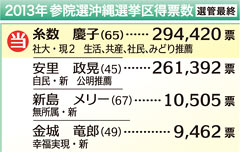
The LDP won a sweeping victory in elections nationwide. However, Itokazu’s victory highlights Okinawan people’s stiff opposition to the policy of the Abe administration to relocate the facilities at U.S. Marine Corps Air Station Futenma within Okinawa.
Itokazu is a candidate of the local party the Okinawa Social Mass Party and was recommended by opposition parties such as the People’s Life Party, the Japanese Communist Party, the Social Democratic Party and the Green Wind. During the election campaign she advocated preserving “one seat for peace.” Referring to the efforts of Prime Minister Shinzo Abe to amend Article 96, which defines the requirements for Constitutional amendment, she emphasized her standpoint of protecting the Constitution, which has won her support.
While Asato and the Okinawa chapter of the LDP have advocated relocating Futenma outside of the prefecture, the LDP headquarters promotes the relocation of Futenma to Henoko as part of its election promise. Itokazu has pointed out that the campaign pledges of the local chapter and the Tokyo headquarters of the LDP are out of kilter. The struggle between the Social Democratic Party and the Communist Party in their local chapters also contributed to her victory. It was beneficial for both parties to support Itokazu to gain votes for their proportional representation candidates. In addition to those of supporters of the opposition parties such as the People’s Life Party, the Japanese Communist Party, the Social Democratic Party and the Green Wind, Itokazu gained far more votes than Asato from independents.
Asato emphasized his ability as a ruling party candidate to affect the execution of policy, but the misaligned pledges of the local chapter and the headquarters of the LDP on the Futenma relocation issue negatively affected his campaign. This delayed his preparation for the election. Party leaders, including the Prime Minister and cabinet ministers came to Okinawa one after another to support his campaign, but his camp was unable to gain the support of the undecided and independent voters.
Other candidates Nijima and Kinjo were unable to get their policies to appeal to the voters.
Voter turnout was 53.43 percent, an increase of 0.99 percent from 52.44 percent in the Upper House election in 2010.
The total number of voters, including those overseas, was 1,102,534 people (535,768 men and 566,766 women).
“The public won the election”Opposition leader Keiko Itokazu commented, “The Okinawan public has won the election. I will be proud to fight against the central government as a member of the House of Councilors from Okinawa. There are problems such as the Constitution, TPP and the consumption tax hike. The Liberal Democratic Party has been the sole winner, but Abenomics will show its true colors soon. I want to work hard in the House for residents and public.”
Keiko Itokazu, who was born October 11, 1947 in Yomitan Village, graduated from Yomitan Senior High School before working as a bus guide. She was first elected as a member of the Okinawa Prefectural Assembly in 1992, serving three terms. She was first elected to the House of Councillors in 2004. She lost the Okinawa gubernatorial election in 2006 and made a come back in the House of Councillors election in 2007. Currently, she is chairwoman of the Okinawa Social Mass Party.
(English translation by T&CT, Mark Ealey)
Go to Japanese












 Webcam(Kokusai Street)
Webcam(Kokusai Street)


